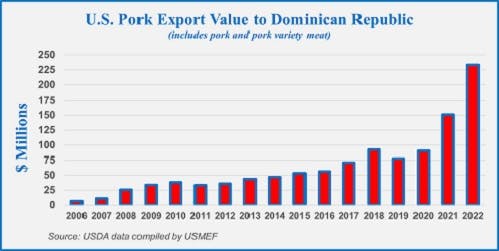U.S. Pork Exports to Dominican Republic Soar to Record Level
Previously a destination for raw material used for further processing, the market now imports a diverse range of U.S. pork cuts and products
The United States has long been the dominant supplier of U.S. soy-fed pork to the Dominican Republic (DR), competing primarily with domestically raised pork. Exports have increased steadily since the DR implemented the Central America-DR-U.S. Free Trade Agreement in 2007, putting U.S. pork on course to enter the market at zero duty.
In 2006, the last year in which U.S. pork was subject to the DR's 25% most-favored-nation tariff rate, U.S. exports were just over 4,000 metric tons, valued at $6.6 million. By 2010, exports more than quadrupled in volume and reached $38 million in value and in 2020, shipments reached nearly 40,000 mt valued at more than $90 million. U.S. exports to the DR were record-shattering in 2022, coming in at 85,550 mt (up 46% from 2021), with value reaching $233.6 million (up 55%), according to USDA data compiled by USMEF.


While the DR was, at one time, primarily a destination for raw material used for further processing, Ruano says the market now offers a diverse range of opportunities for U.S. exporters. "The U.S. industry has made tremendous strides in supplying center-of-the-plate cuts to retail and foodservice clientele and convenience-based items that hold great appeal for consumers," she said. "With the scope of pork cuts and products we are now featuring in the DR, this is a very exciting market that holds potential for further growth."
Funding support for promotional activities in the DR is provided by the National Pork Board, the soybean checkoff and USDA’s Market Access Program and Agricultural Trade Promotion program.
